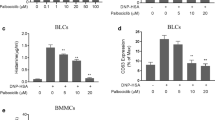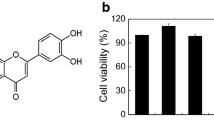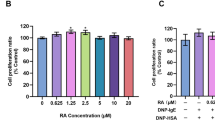Abstract
Purpose
Ephedra herb (Mao) exerts potent anti-allergic effects. This study aimed to examine the underlying mechanisms of Mao on allergic inflammation using in vitro cultured mast cells (MCs) and an in vivo model of MC-dependent anaphylaxis.
Methods
Bone marrow-derived MCs (BMMCs) were presensitized with anti-2,4-dinitrophenol (DNP) immunoglobulin E (IgE) and challenged with antigens (Ag; DNP-human serum albumin). Degranulation responses and cell surface high-affinity receptor for IgE (FcεRI) expression were assessed with/without Mao treatment. Passive systemic anaphylaxis (PSA)-treated mice were administered Mao and the pathophysiological responses were evaluated.
Results
Mao inhibited Ag-induced BMMC degranulation, but not polyclonal activation with phorbol 12-myristate 13-acetate (PMA) and ionomycin, indicating that Mao inhibits IgE-dependent activation of BMMCs. Mao-treated BMMCs exhibited significant reductions in expression of surface IgE and its receptor FcεRI. Analysis of subcellular localization revealed that Mao induces FcεRI internalization in BMMCs without degranulation. In the PSA mouse model, Mao administration prevented antigen-induced hypothermia. Mao administration significantly reduced cell surface expression of IgE-bound FcεRI on peritoneal MCs.
Conclusions
Mao induced FcεRI internalization in MCs, thereby inhibiting Ag-induced IgE-dependent degranulation. The inhibitory effects of Mao on MC degranulation may offer a novel therapeutic approach for allergic diseases.






Similar content being viewed by others
Abbreviations
- Ag:
-
Antigen
- AIT:
-
Antigen specific immunotherapy
- BMMC:
-
Bone marrow-derived mast cell
- CLSM:
-
Confocal laser scanning microscope
- DNP:
-
2,4-dinitrophenol
- FcεRI:
-
High-affinity receptor for immunoglobulin E
- HSA:
-
Human serum albumin
- IgE:
-
Immunoglobulin E
- MC:
-
Mast cell
- PBS:
-
Phosphate buffered saline
- PMA:
-
Phorbol 12-myristate 13-acetate
- PMC:
-
Peritoneal mast cell
- TNF-α:
-
Tumor necrosis factor-α
References
Elieh Ali Komi D, Bjermer L. Mast cell-mediated orchestration of the immune responses in human allergic asthma: current insights. Clin Rev Allergy Immunol. 2019;56(2):234–47.
Galli SJ, Tsai M. IgE and mast cells in allergic disease. Nat Med. 2012;18(5):693–704.
Akdis M, Akdis CA. Mechanisms of allergen-specific immunotherapy: multiple suppressor factors at work in immune tolerance to allergens. J Allergy Clin Immunol. 2014;133(3):621–31.
Gomez G. Current strategies to inhibit high affinity FcepsilonRI-mediated signaling for the treatment of allergic disease. Front Immunol. 2019;10:175.
Gomez G, Jogie-Brahim S, Shima M, Schwartz LB. Omalizumab reverses the phenotypic and functional effects of IgE-enhanced Fc epsilonRI on human skin mast cells. J Immunol (Baltimore, Md : 1950). 2007;179(2):1353–61.
Tonacci A, Billeci L, Pioggia G, Navarra M, Gangemi S. Omalizumab for the treatment of chronic idiopathic Urticaria: systematic review of the literature. Pharmacotherapy. 2017;37(4):464–80.
Pennington LF, Tarchevskaya S, Brigger D, Sathiyamoorthy K, Graham MT, Nadeau KC, et al. Structural basis of omalizumab therapy and omalizumab-mediated IgE exchange. Nat Commun. 2016;7:11610.
Baumann MJ, Eggel A, Amstutz P, Stadler BM, Vogel M. DARPins against a functional IgE epitope. Immunol Lett. 2010;133(2):78–84.
Zhu D, Kepley CL, Zhang M, Zhang K, Saxon A. A novel human immunoglobulin fc gamma fc epsilon bifunctional fusion protein inhibits fc epsilon RI-mediated degranulation. Nat Med. 2002;8(5):518–21.
Sakai S, Sugawara T, Matsubara K, Hirata T. Inhibitory effect of carotenoids on the degranulation of mast cells via suppression of antigen-induced aggregation of high affinity IgE receptors. J Biol Chem. 2009;284(41):28172–9.
Tokura T, Nakano N, Ito T, Matsuda H, Nagasako-Akazome Y, Kanda T, et al. Inhibitory effect of polyphenol-enriched apple extracts on mast cell degranulation in vitro targeting the binding between IgE and FcepsilonRI. Biosci Biotechnol Biochem. 2005;69(10):1974–7.
Nakano N, Nishiyama C, Tokura T, Nagasako-Akazome Y, Ohtake Y, Okumura K, et al. Procyanidin C1 from apple extracts inhibits fc epsilon RI-mediated mast cell activation. Int Arch Allergy Immunol. 2008;147(3):213–21.
Lopez-Exposito I, Castillo A, Yang N, Liang B, Li XM. Chinese herbal extracts of Rubia cordifolia and Dianthus superbus suppress IgE production and prevent peanut-induced anaphylaxis. Chin Med. 2011;6:35.
Lee E, Kim SG, Park NY, Park HH, Jeong KT, Choi J, et al. KOTMIN13, a Korean herbal medicine alleviates allergic inflammation in vivo and in vitro. BMC Complement Altern Med. 2016;16:169.
Kageyama-Yahara N, Suehiro Y, Maeda F, Kageyama S, Fukuoka J, Katagiri T, et al. Pentagalloylglucose down-regulates mast cell surface FcepsilonRI expression in vitro and in vivo. FEBS Lett. 2010;584(1):111–8.
Wang X, Kageyama-Yahara N, Hayashi S, Yamamoto T, Kadowaki M. Sphingosine kinase-1-dependent and -independent inhibitory effects of zanthoxyli fructus to attenuate the activation of mucosal mast cells and ameliorate food allergies in mice. Evid Based Complement Alternat Med. 2012;2012:862743.
Matsuo K, Koizumi K, Fujita M, Morikawa T, Jo M, Shibahara N, et al. Efficient use of a crude drug/herb library reveals Ephedra herb as a specific antagonist for TH2-specific chemokine receptors CCR3, CCR4, and CCR8. Front Cell Dev Biol. 2016;4:54.
Saito SY, Maruyama Y, Kamiyama S, Nakahata N, Ohizumi Y. Ephedrae herba in Mao-Bushi-Saishin-to inhibits IgE-mediated histamine release and increases cAMP content in RBL-2H3 cells. J Pharmacol Sci. 2004;95(1):41–6.
Amakura Y, Yoshimura M, Yamakami S, Yoshida T, Wakana D, Hyuga M, et al. Characterization of phenolic constituents from ephedra herb extract. Molecules. 2013;18(5):5326–34.
Amakura Y. Characterization of phenolic constituents from Ephedra herb extract. Yakugaku Zasshi. 2017;137(2):167–71.
Hyuga S, Hyuga M, Oshima N, Maruyama T, Kamakura H, Yamashita T, et al. Ephedrine alkaloids-free Ephedra herb extract: a safer alternative to ephedra with comparable analgesic, anticancer, and anti-influenza activities. J Nat Med. 2016;70(3):571–83.
Nakamori S, Takahashi J, Hyuga S, Yang J, Takemoto H, Maruyama T, et al. Analgesic effects of Ephedra herb extract, ephedrine alkaloids-free Ephedra herb extract, ephedrine, and pseudoephedrine on formalin-induced pain. Biol Pharm Bull. 2019;42(9):1538–44.
Kay LJ, Peachell PT. Mast cell beta2-adrenoceptors. Chem Immunol Allergy. 2005;87:145–53.
Suzuki R, Leach S, Liu W, Ralston E, Scheffel J, Zhang W, et al. Molecular editing of cellular responses by the high-affinity receptor for IgE. Science. 2014;343(6174):1021–5.
Kuo CH, Collins AM, Boettner DR, Yang Y, Ono SJ. Role of CCL7 in Type I hypersensitivity reactions in murine experimental allergic conjunctivitis. J Immunol (Baltimore, Md : 1950). 2017;198(2):645–56.
Oka T, Rios EJ, Tsai M, Kalesnikoff J, Galli SJ. Rapid desensitization induces internalization of antigen-specific IgE on mouse mast cells. J Allergy Clin Immunol. 2013;132(4):922–32.e1–16.
Berings M, Karaaslan C, Altunbulakli C, Gevaert P, Akdis M, Bachert C, et al. Advances and highlights in allergen immunotherapy: on the way to sustained clinical and immunologic tolerance. J Allergy Clin Immunol. 2017;140(5):1250–67.
Kulis MD, Patil SU, Wambre E, Vickery BP. Immune mechanisms of oral immunotherapy. J Allergy Clin Immunol. 2018;141(2):491–8.
Gasser P, Tarchevskaya SS, Guntern P, Brigger D, Ruppli R, Zbären N, et al. The mechanistic and functional profile of the therapeutic anti-IgE antibody ligelizumab differs from omalizumab. Nat Commun. 2020;11(1):165.
Yokawa S, Suzuki T, Hayashi A, Inouye S, Inoh Y, Furuno T. Video-rate bioluminescence imaging of degranulation of mast cells attached to the extracellular matrix. Front Cell Dev Biol. 2018;6:74.
Pfeiffer JR, Seagrave JC, Davis BH, Deanin GG, Oliver JM. Membrane and cytoskeletal changes associated with IgE-mediated serotonin release from rat basophilic leukemia cells. J Cell Biol. 1985;101(6):2145–55.
Barnes PJ. Effect of beta-agonists on inflammatory cells. J Allergy Clin Immunol. 1999;104(2 Pt 2):S10–7.
Weston MC, Peachell PT. Regulation of human mast cell and basophil function by cAMP. Gen Pharmacol. 1998;31(5):715–9.
Shibata H, Nabe T, Yamamura H, Kohno S. L-ephedrine is a major constituent of Mao-Bushi-Saishin-to, one of the formulas of Chinese medicine, which shows immediate inhibition after oral administration of passive cutaneous anaphylaxis in rats. Inflamm Res. 2000;49(8):398–403.
Shibata H, Minami E, Hirata R, Mizutani N, Nabe T, Kohno S. Immediate inhibition by oral l-ephedrine of passive cutaneous anaphylaxis of rats: indirect inhibition of anaphylactic chemical mediator release from the mast cell. Inflamm Res. 2000;49(10):553–9.
Fujimura Y, Tachibana H, Maeda-Yamamoto M, Miyase T, Sano M, Yamada K. Antiallergic tea catechin, (−)-epigallocatechin-3-O-(3-O-methyl)-gallate, suppresses FcepsilonRI expression in human basophilic KU812 cells. J Agric Food Chem. 2002;50(20):5729–34.
Yano S, Tachibana H, Yamada K. Flavones suppress the expression of the high-affinity IgE receptor FcepsilonRI in human basophilic KU812 cells. J Agric Food Chem. 2005;53(5):1812–7.
Kawakami T, Blank U. From IgE to omalizumab. J Immunol (Baltimore, Md : 1950). 2016;197(11):4187–92.
Kubo S, Matsuoka K, Taya C, Kitamura F, Takai T, Yonekawa H, et al. Drastic up-regulation of Fcepsilonri on mast cells is induced by IgE binding through stabilization and accumulation of Fcepsilonri on the cell surface. J Immunol (Baltimore, Md : 1950). 2001;167(6):3427–34.
Borkowski TA, Jouvin MH, Lin SY, Kinet JP. Minimal requirements for IgE-mediated regulation of surface Fc epsilon RI. J Immunol (Baltimore, Md : 1950). 2001;167(3):1290–6.
Author information
Authors and Affiliations
Contributions
YN, HA, YS, and RS contributed by conducting experiments, summarizing data, and/or generating necessary reagents. YN and RS conceived and directed this study. YN, HA, YS, and RS participated in the writing of the manuscript.
Corresponding author
Ethics declarations
Research Involving Human Participants and/or Animals
All applicable international, national, and/or institutional guidelines for the care and use of animals were followed.
Informed Consent
No informed consent was required to prepare the manuscript.
Conflict of Interest
This research was supported by JSPS KAKENHI Grant Number 16H05082. The authors have no conflicting financial interests.
Additional information
Publisher’s Note
Springer Nature remains neutral with regard to jurisdictional claims in published maps and institutional affiliations.
Supplementary Information
ESM 1
(DOCX 44127 kb)
Rights and permissions
About this article
Cite this article
Nagata, Y., Ando, H., Sasaki, Y. et al. Ephedra Herb, Mao, Inhibits Antigen-Induced Mast Cell Degranulation by Induction of the Affinity Receptor for IgE Internalization. Pharm Res 38, 569–581 (2021). https://doi.org/10.1007/s11095-021-03020-0
Received:
Accepted:
Published:
Issue Date:
DOI: https://doi.org/10.1007/s11095-021-03020-0




